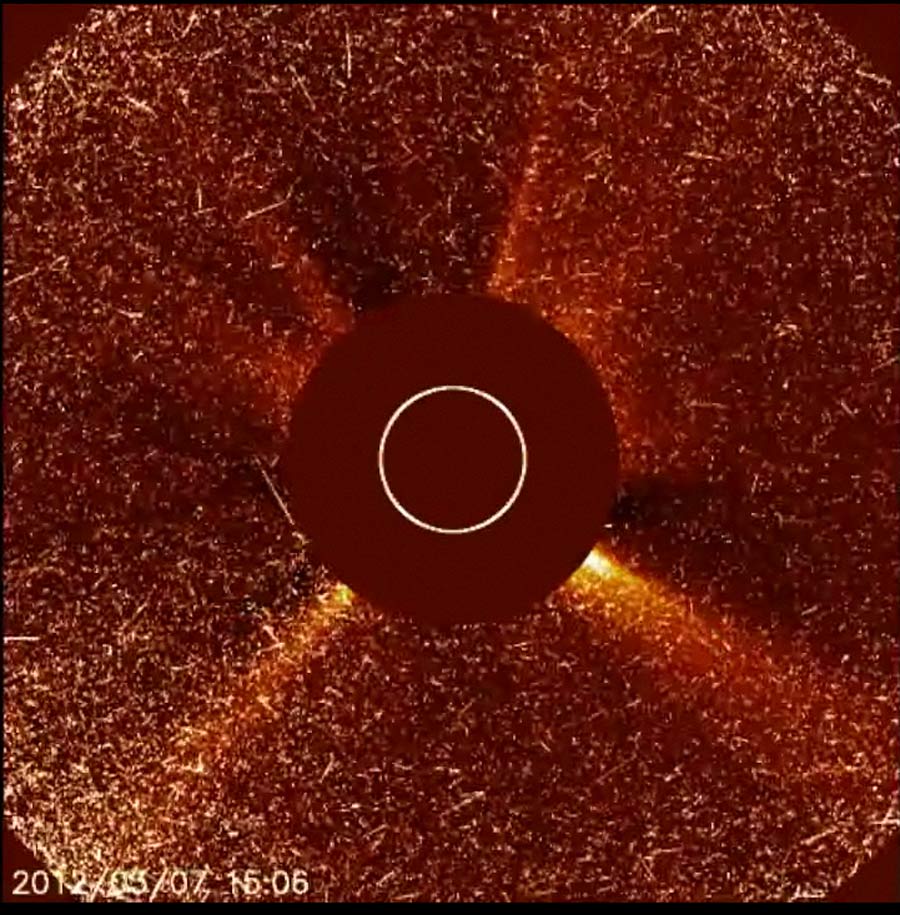Solar Storm Soundtrack Recorded in New Sun Video

A new video captures the frenzied sounds of a sun storm, based on data recorded by two spacecraft as they were bombarded with charged particles during a recent solar eruption.
The video is a visual and auditory glimpse of the sun in early March, when it erupted in the strongest solar storm in eight years. The storm unleashed a wave of solar plasma and energetic particles, which NASA's Messenger spacecraft at Mercury and the sun-watching Solar and Heliospheric Observatory recorded during the cosmic barrage.
Robert Alexander, a design science doctoral student at the University of Michigan in Ann Arbor, created the video using a technique that "sonifies" the measurements from the two spacecraft. Alexander is a composer with a NASA fellowship to study how representing information as sound could help scientists with analysis and data mining.
Sonification is the process of converting information and data into sound. This practice is used in Geiger counter radiation detectors, which emit clicks when exposed to high-energy particles. While sonification is not generally used to detect patterns in sets of data, scientists at the University of Michigan's Solar and Heliospheric Research Group are interesting in probing the potential benefits.
"Robert is giving us another research tool," Jim Raines, a lead mission operations engineer at the University of Michigan's Space Physics Research Lab, said in a statement. "We're used to looking at wiggly-line plots and graphs, but humans are very good at hearing things. We wonder if there's a way to find things in the data that are difficult to see." [Video: The Sound of a Solar Storm]
Alexander began by translating 90 hours worth of raw information into audio waveform, and then adjusted the playback rate by running it through a series of algorithms. Without slowing down the playback rate, several days worth of data can be zipped through in fractions of a second.
"This approach is changing the timescale for us," Raines said. "It's really interesting to hear it."
Breaking space news, the latest updates on rocket launches, skywatching events and more!
Alexander has actually been developing the technique for several years, and in December of 2011 it paid off. The sonification approach led to a new discovery that a particular ratio of carbon atoms that scientists had not previously detected can reveal more about the source of the solar wind than the ratios of elements they currently monitor to make their measurements. Solar wind is made up of waves of hot plasma and charged particles that are continuously emitted from the sun.
The details of that earlier solar wind study were described in the December 2011 edition of the Astrophysical Journal.
Alexander is hoping to hone the sonification technique in order to create a useful bridge between science and art, particularly as the sun ramps up toward the peak of its current solar weather cycle, which is expected to reach its maximum in 2013.
"For a while, movies were silent and people just accepted that that's the way it is," Alexander said in a statement. "There's all this high res footage of what's happening on the surface of the sun, and it's silent. I'm creating a soundtrack."
Follow SPACE.com for the latest in space science and exploration news on Twitter @Spacedotcom and on Facebook.

Space.com is the premier source of space exploration, innovation and astronomy news, chronicling (and celebrating) humanity's ongoing expansion across the final frontier. Originally founded in 1999, Space.com is, and always has been, the passion of writers and editors who are space fans and also trained journalists. Our current news team consists of Editor-in-Chief Tariq Malik; Editor Hanneke Weitering, Senior Space Writer Mike Wall; Senior Writer Meghan Bartels; Senior Writer Chelsea Gohd, Senior Writer Tereza Pultarova and Staff Writer Alexander Cox, focusing on e-commerce. Senior Producer Steve Spaleta oversees our space videos, with Diana Whitcroft as our Social Media Editor.
